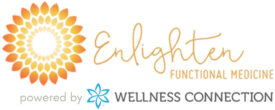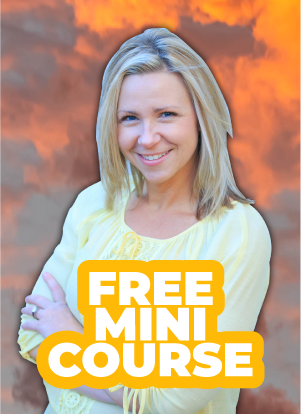By Amy Hadden, FMCHC
When you first envisioned the 2020 new year, pandemic probably wasn’t on your radar. However, the effects of COVID-19 are real, they’re heavy and they’re close to home. All aspects of life are influenced by the overwhelming uncertainty each day brings.
Where do you find your sense of balance, health and wellbeing amidst chaos–especially if you’re suddenly homeschooling? Here’s 10 practical tips for how to balance home life and school life all while guarding the space needed to cultivate a calm mind and body.
Tip 1: Get Back to the Basics of Health
What’s the foundation to balancing kids, home and pandemic? While a color-coded schedule, a pantry full of snacks and a craft closet may seem like go-to tools, it can be helpful to start at square one. Hone in on the basics of good sleep, social connection, movement and nutrition. These make up what are considered the pillars of a functional medicine approach to health.
In positive psychology coaching, domains of health and wellbeing can be looked at through the acronym SPIRE created by Dr. Tal Ben-Shahar. (1)
Spiritual
Physical
Intellectual
Relational
Emotional
The word spire is related to the word respire, as in breathing. Also, it can refer to the highest point of a building. In Tal Ben-Shahar’s model of wellness, each part of SPIRE is seen as affecting all the other parts. By intentionally working on one area, it will boost satisfaction in the other areas.
In times of crisis, it can be helpful to check-in with yourself and ask how you’re doing in each area using the SPIRE model. What’s one area from the SPIRE domains that you’d like to see a shift in this week? What small step you might take in the next few days to make a small difference?

Tip 2: Honor and Leverage Uniqueness
You don’t have to have a background in education or psychology to understand and celebrate your kid’s unique learning styles, intelligence and strengths.
Scientific VIA Character Strengths
Character strengths are the positive parts of our personalities. Scientists discovered this common language of 24 character strengths that are the same worldwide, no matter your culture background or geographical location Instead of working on weaknesses, research with character strengths shows that the key to success is actually maximizing what you already naturally do well. Take the free scientific VIA Character Strengths Survey at https://www.viacharacter.org/.
Right now, as we are surrounded by uncertainty, these positive parts of our personalities influence what we say, think, feel and do. Knowing your unique combinations of strengths can give insight into how to approach struggle–whether it’s a stressful decision, a trying conversation or an overwhelming pandemic.
Character Strengths in Kids
Research shows that all children possess the potential to express all 24 character strengths. If you have a child that is at least 10 years old, VIA also has a free online youth survey. Consider printing out the results of both you and your children and putting them on the fridge as a first step.
Knowing these unique characteristics in your child helps lead the way in strengths-based parenting. Instead of approaching your child with a “What needs to be changed and fixed?” question, it centers on “What strengths would be helpful in this situation?” question.
Even without taking the survey, parents can just start noticing strengths in their kiddo. Then, verbalize it, “Hey, I noticed your creativity helped you figure out a new way to solve that problem.” Strength-based parenting celebrates and discusses a kid’s strengths and creates opportunities to utilize these strengths.
According to the website for the VIA Institute on Character:
“Research indicates children and teenagers with strength-based parents are less stressed, better at handling friendship issues, better at meeting homework deadlines, and get better grades—important counterweights to concerns about teen depression, bullying, and underachievement.”

Gardner’s Multiple Intelligences
There’s more than one way to be smart. Harvard psychologist Howard Gardner’s Multiple Intelligence Theory proposes different domains of intelligence beyond an IQ score-based intelligence: visual-spatial, linguistic-verbal, interpersonal, intrapersonal, logical-mathematical, musical, bodily-kinesthetic, naturalistic, existential. (2)
By simply being aware of these unique qualities and differences in your children, you may garner greater insight into what each particular kiddo needs to succeed. And, while you don’t need to bend-over backwards to create a new assignment for them, just considering a bit about how your kid ticks might help you brainstorm ways to fight boredom during quarantine’s monotony.
Does your nature-loving kid want to write her spelling words in sidewalk chalk on the back porch while listening to the birds? Maybe your art-loving visual-spatial 6th grader wants to use Legos people and iMovie to retell his assigned novel making a stop-motion production? Does your pre-teen need extra phone time with a bestie to verbally process all the changes taking place now that school is online?
Tip 3: Check Expectations
Just because your kiddo was at school from 8:00 a.m.-3:00 p.m. does not mean that you now suddenly need to bring in 7 hours of academic work.

How long should an at-home school day be?
The National Board for Professional Teaching Standards hosted a webinar entitled “Take it Offline” where leaders in the field of education gave these instructional time guidelines for at-home education during this pandemic: (3)
- Elementary school: 1-2 hours per day
- Middle school: 2-3 hours per day
- High school: 3-4 hours per day
They recommended at least 1 hour of outside time each day as well, all while following social distancing guidelines.
Do I have enough learning supplies?
Also, pandemic homeschooling doesn’t mean that you have to order a bunch of workbooks, online educational subscriptions or pin a thousand learning games. You don’t have to become a homerun homeschooling mom, unless you just want to.
Research shows time and time again that a student-centered educational approach is most effective. What might that look like in your own house?
How much help do my kids need from me while learning?
Even if your child’s school is providing academic support during COVID-19, be it online or paper and pencil activities, be prepared for a need for additional parental supervision and support.
In a typical classroom setting, any assignment will consist of whole group instruction with hands-on demonstrations followed by independent work with teacher assistance.
Now, you’re the teacher. Just because you’re working from home and have four Zoom meetings today doesn’t mean that your child is going to be successful on his or her own. This is where communication, planning and a fluid schedule may come in handy.
Tip 4: Get Ready for Behavioral Challenges
When it rains, it pours. It is very likely challenging behaviors will be on the rise in your kiddo during these stressful times. They sense the stress around them, have been taken from their familiar routines and friends. Pad the day with extra doses of patience and empathy.
All of our nervous systems are influenced by the disrupted schedules, the restrictions in movement and perhaps a tad-too-much together time. Just as emotions can run high leading to meltdowns and angry outbursts, the effect of stress on our nervous systems may mean extra movement breaks, alone time, or intentional sensory input are needed.
Tip 5: Consider the Power of Personal Choice
As humans, we like choice. We value options. That’s one reason this time is so hard for us, even as adults. Kids are the same. Consider ways you might give your kids options in a world where their power to choose has been slashed. In essence, let them control something.
You might want to think of options as making deposits in our kid’s “choice bank.” This might be about meals, activities or just the order of completing tasks. Giving kids more choices can help when you need to “make a withdrawal” from their account, such as when they do not get a choice (i.e. bedtime).
Choice is motivating. Kids will be more engaged and productive in activities that they enjoy (read: you might actually make it through the entire Zoom call without needing to intervene on the needs of your young “co-workers.”)
Tip 6: Embrace the Healing Power of Downtime and Personal Space
According to child and adolescent psychotherapist Dr. Tina Payne Bryson, teens are in a developmental space that needs space and independence. During a time of pandemic quarantine, this might look like more earbuds and closed doors to create space. (4)
Some kids (of any age) are sensitive to noise and may benefit from a break from siblings and background music.
Tip 7: Prioritize Playtime
Pediatricians are prescribing play because there’s a cultural deficit. The American Academy of Pediatrics issued a policy recommending more unscheduled free play. (5) Developmentally appropriate play affects cognition, language development, problem-solving abilities and influences brain structure and executive functioning skills.
During times of stress, this is especially important. Play is how kids process the world around them. Also, from the work of Dr. Stephen Porges, PhD, we see how play with others helps promote self-regulation. It’s a time to engage the fight or flight response in the context of social engagement which dampens the effect. (6)
Tip 8: Schedule Connection
Social connection is the fast track to wellbeing. Make a mental note of your family members’ connection buckets. How will you fill it up each day?
- Record videos to send to their elementary age friends
- Let kids interview a grandparent on the phone each week
- Host a Zoom or Google Hangouts dance party with the cousins
- Invite friends and family over to dinner via Facetime
Using the language of a connection bucket with your kids might give them a way to verbalize their needs for connection.
Tip 9: End Tough Conversations on Positive Notes
When balancing home, news and kids, stress will run high. How much should children know about what’s going on in the world around them? Parents can be intentional with providing developmentally appropriate amounts of information.
Having the news on 24/7 can cause increased anxiety in both children and adults. Filter the message and end it on a positive note. This might sound like, “Wow, there’s so much we don’t know about this virus and it’s really impacting our city, our state, our country and our world. The good news is that we’re able to decrease the spread of things by staying home. The helpers in the world are learning more each day about this virus to keep us all safe.”
Also, emphasize a positive tone through conversations. The right hemisphere of the brain detects the meaning from tone while the left hemisphere dissects the meaning from words. But, your brain trusts the right hemisphere more. Be careful with tone when relaying information about media coverage.
Tip 10: Lead by Example: Self-regulation and Self-care
As caregivers, we set the emotional tone. It’s possible to be physically present without being emotionally present. In this crisis, it’s our job to model how to handle big emotions and challenging times.
If watching the news and feeling tense, you can say…”Gosh, all this makes me feel stressed and I’m really glad there’s so many people working on solving this problem. I really feel some tension in my shoulders, how about we go for a walk?”
Name it to tame it. This moves us from a lower part of the brain to the thinking prefrontal cortex. Doing it in front of our kids can help them learn to do it for themselves.

Three quick tips for self-care and self-regulation:
-
- Just Breathe: Take 3 deep breaths, making your exhale longer than your inhale. This regulates the nervous system and dampens the stress response.
- Move outdoors: The combination of movement and nature can soothe your mind and body. If you can’t go outdoors, then look out the window.
- Check-in: Close your eyes and notice your breath without trying to change it. Notice where you feel any tension: your neck, your shoulders, your back? Bring attention to the area of tightness and release.
Beyond that, know yourself and your needs. What makes stress better? What makes it worse?
You may find yourself altering the time you spend on social media. You may need to ease the expectations you set on yourself for the completion of housework chores. It’s a time to feed your soul. If you have songs that speak to your heart, don’t be afraid to play them on repeat. Sing. Pray. Read. Engage with that which brings you life and hope. Don’t underestimate the power of nature to soothe, whether it be a star-gazing stroll, listening to the birds sing in the morning sun, or a heart-pounding trail run.
Beyond inspiration and hope, you may need to find a safe place for mental escape like in a fictional audiobook or a creative outlet. Even just looking at Pinterest crafts you’ll never actually do is a way to disengage from stress, give your brain a break and re-engage with creativity and beauty.
Anchored in a Chaotic Storm
In a raging storm we need anchors to stay afloat. These 10 tips give clues to how to find a bit of calm in the chaos of COVID-19. However, ultimately, the best approach is one that encourages a sense of safety and compassion for each family member. What does that look like for you? How will you support yourself in the storm?
Free Functional Medicine Coaching Resources
Group Support for Moms
During April and May, you can connect online with other moms and Functional Medicine Certified Health Coach Amy Hadden.
Meet through the online platform Zoom on Saturdays at 3:00 p.m. (CDT) for an hour of social connection, grounding techniques and group support. Come once or as many times as you’d like. This is a drop-in format. However, you will need to register before attending.
One-on-one Strength and Resilience Session
In response to these turbulent times, you can take part in a free 45 minute functional medicine coaching session. This is available to adults, teens and children 10 and over. Fill out this form to schedule or learn more.
Sources:
- “Wholebeing Happiness and the SPIRE Approach … – YouTube.” 15 Nov. 2018, https://www.youtube.com/watch?v=pkccfetyoz8. Accessed 31 Mar. 2020.
- “Howard Gardner’s theory of Multiple Intelligences – Northern ….” https://www.niu.edu/facdev/_pdf/guide/learning/howard_gardner_theory_multiple_intelligences.pdf. Accessed 31 Mar. 2020.
- “COVID-19 – NBPTS | Shaping the profession that shapes ….” https://www.nbpts.org/covid-19/. Accessed 31 Mar. 2020.
- “WHYY radio (90.9 FM) & NPR Sirius: “Parenting during the ….” 24 Mar. 2020, https://www.tinabryson.com/podcasts-audio-interviews/nbspwhyynbspradio-909-fm-amp-npr-sirius-parenting-during-the-pandemic. Accessed 31 Mar. 2020.
- “Power of Play: A Pediatric Role in ….” 1 Sep. 2018, https://pediatrics.aappublications.org/content/142/3/e20182058. Accessed 31 Mar. 2020.
- “131. COVID-19 Anxiety, Cultivating Safeness, and Polyvagal ….” 26 Mar. 2020, https://www.offtheclockpsych.com/podcast/covid-19-anxiety-cultivating-safeness. Accessed 31 Mar. 2020.





